名词性从句最详讲解及习题与答案
- 格式:doc
- 大小:97.00 KB
- 文档页数:13
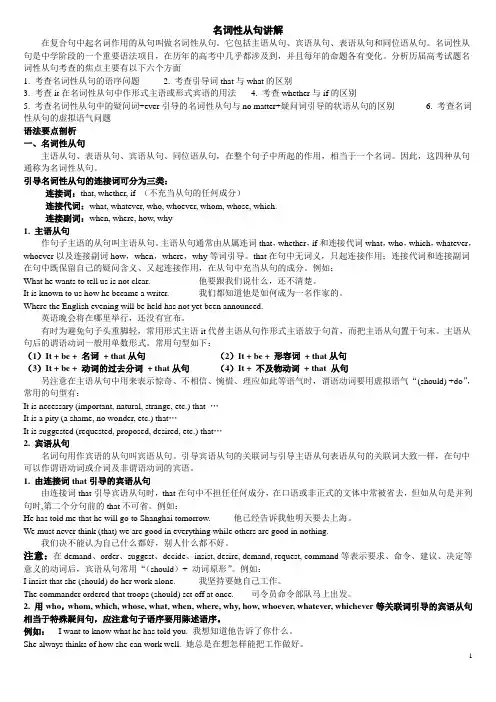
名词性从句讲解在复合句中起名词作用的从句叫做名词性从句。
它包括主语从句、宾语从句、表语从句和同位语从句。
名词性从句是中学阶段的一个重要语法项目,在历年的高考中几乎都涉及到,并且每年的命题各有变化。
分析历届高考试题名词性从句考查的焦点主要有以下六个方面1. 考查名词性从句的语序问题2. 考查引导词that与what的区别3. 考查it在名词性从句中作形式主语或形式宾语的用法4. 考查whether与if的区别5. 考查名词性从句中的疑问词+ever引导的名词性从句与no matter+疑问词引导的状语从句的区别6. 考查名词性从句的虚拟语气问题语法要点剖析一、名词性从句主语从句、表语从句、宾语从句、同位语从句,在整个句子中所起的作用,相当于一个名词。
因此,这四种从句通称为名词性从句。
引导名词性从句的连接词可分为三类:连接词:that, whether, if (不充当从句的任何成分)连接代词:what, whatever, who, whoever, whom, whose, which.连接副词:when, where, how, why1. 主语从句作句子主语的从句叫主语从句。
主语从句通常由从属连词that,whether,if和连接代词what,who,which,whatever,whoever以及连接副词how,when,where,why等词引导。
that在句中无词义,只起连接作用;连接代词和连接副词在句中既保留自己的疑问含义、又起连接作用,在从句中充当从句的成分。
例如:What he wants to tell us is not clear. 他要跟我们说什么,还不清楚。
It is known to us how he became a writer. 我们都知道他是如何成为一名作家的。
Where the English evening will be held has not yet been announced.英语晚会将在哪里举行,还没有宣布。
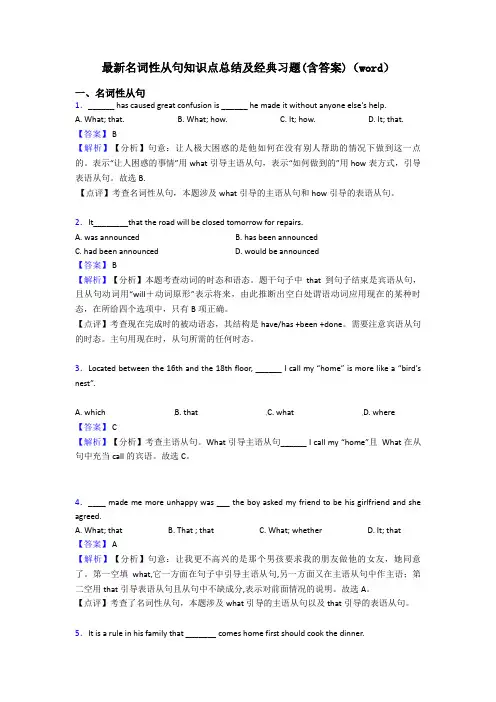
最新名词性从句知识点总结及经典习题(含答案)(word)一、名词性从句1.______ has caused great confusion is ______ he made it without anyone else's help. A. What; that. B. What; how. C. It; how. D. It; that.【答案】 B【解析】【分析】句意:让人极大困惑的是他如何在没有别人帮助的情况下做到这一点的。
表示“让人困惑的事情”用what引导主语从句,表示“如何做到的”用how表方式,引导表语从句。
故选B.【点评】考查名词性从句,本题涉及what引导的主语从句和how引导的表语从句。
2.It________that the road will be closed tomorrow for repairs.A. was announcedB. has been announcedC. had been announcedD. would be announced【答案】 B【解析】【分析】本题考查动词的时态和语态。
题干句子中that到句子结束是宾语从句,且从句动词用“will+动词原形”表示将来,由此推断出空白处谓语动词应用现在的某种时态,在所给四个选项中,只有B项正确。
【点评】考查现在完成时的被动语态,其结构是have/has +been +done。
需要注意宾语从句的时态。
主句用现在时,从句所需的任何时态。
3.Located between the 16th and the 18th floor, ______ I call my “home” is more like a “bird's nest”.A. whichB. thatC. whatD. where【答案】 C【解析】【分析】考查主语从句。
What引导主语从句______ I call my “home”且 What在从句中充当call的宾语。
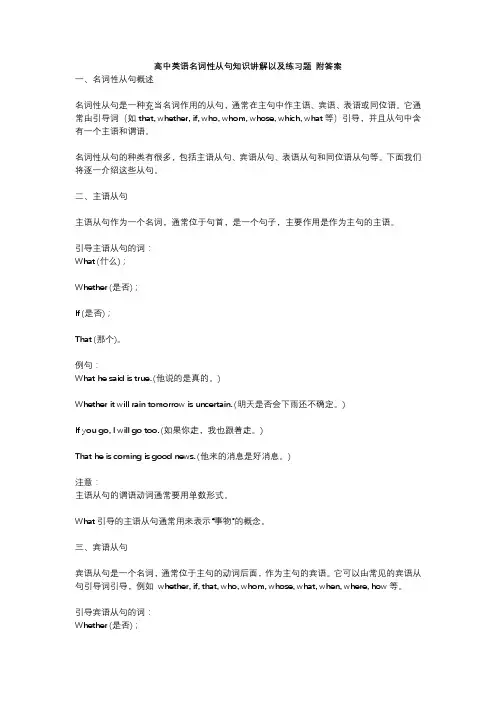
高中英语名词性从句知识讲解以及练习题附答案一、名词性从句概述名词性从句是一种充当名词作用的从句,通常在主句中作主语、宾语、表语或同位语。
它通常由引导词(如that, whether, if, who, whom, whose, which, what等)引导,并且从句中含有一个主语和谓语。
名词性从句的种类有很多,包括主语从句、宾语从句、表语从句和同位语从句等。
下面我们将逐一介绍这些从句。
二、主语从句主语从句作为一个名词,通常位于句首,是一个句子,主要作用是作为主句的主语。
引导主语从句的词:What (什么);Whether (是否);If (是否);That (那个)。
例句:What he said is true. (他说的是真的。
)Whether it will rain tomorrow is uncertain. (明天是否会下雨还不确定。
)If you go, I will go too. (如果你走,我也跟着走。
)That he is coming is good news. (他来的消息是好消息。
)注意:主语从句的谓语动词通常要用单数形式。
What引导的主语从句通常用来表示“事物”的概念。
三、宾语从句宾语从句是一个名词,通常位于主句的动词后面,作为主句的宾语。
它可以由常见的宾语从句引导词引导,例如whether, if, that, who, whom, whose, what, when, where, how等。
引导宾语从句的词:Whether (是否);If (是否);That (那个);Who (谁);Whom (谁);Whose (谁的);What (什么);When (何时);Where (何处);How (如何)。
例句:I know that he is coming. (我知道他要来。
)I wonder if he is telling the truth. (我想知道他是否说了真话。
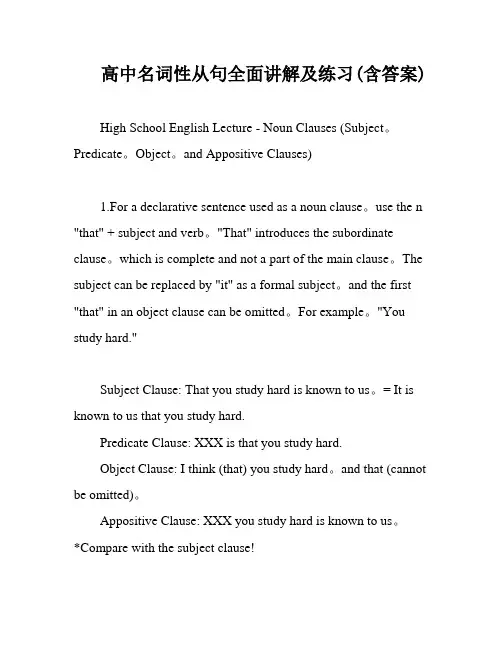
高中名词性从句全面讲解及练习(含答案)High School English Lecture - Noun Clauses (Subject。
Predicate。
Object。
and Appositive Clauses)1.For a declarative sentence used as a noun clause。
use the n "that" + subject and verb。
"That" introduces the subordinate clause。
which is complete and not a part of the main clause。
The subject can be replaced by "it" as a formal subject。
and the first "that" in an object clause can be omitted。
For example。
"You study hard."Subject Clause: That you study hard is known to us。
= It is known to us that you study hard.Predicate Clause: XXX is that you study hard.Object Clause: I think (that) you study hard。
and that (cannot be omitted)。
Appositive Clause: XXX you study hard is known to us。
*Compare with the subject clause!If a XXX clarifies an abstract noun。
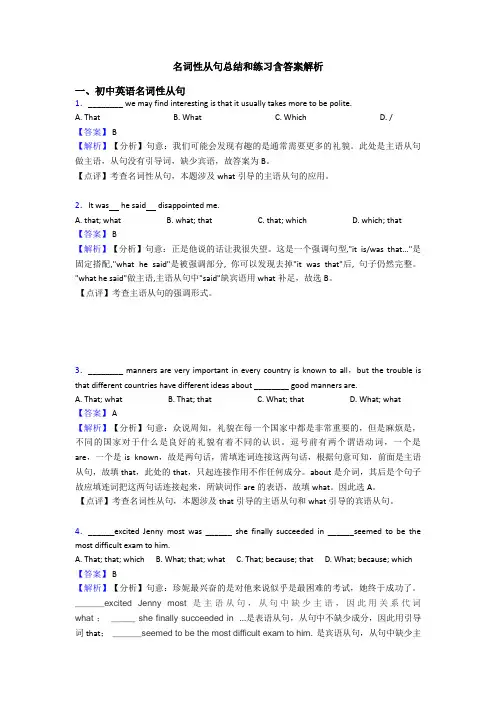
名词性从句总结和练习含答案解析一、初中英语名词性从句1.________ we may find interesting is that it usually takes more to be polite.A. ThatB. WhatC. WhichD. /【答案】 B【解析】【分析】句意:我们可能会发现有趣的是通常需要更多的礼貌。
此处是主语从句做主语,从句没有引导词,缺少宾语,故答案为B。
【点评】考查名词性从句,本题涉及what引导的主语从句的应用。
2.It was he said disappointed me.A. that; whatB. what; thatC. that; whichD. which; that【答案】 B【解析】【分析】句意:正是他说的话让我很失望。
这是一个强调句型,"it is/was that..."是固定搭配,"what he said"是被强调部分, 你可以发现去掉"it was that"后, 句子仍然完整。
"what he said"做主语,主语从句中"said"缺宾语用what补足,故选B。
【点评】考查主语从句的强调形式。
3.________ manners are very important in every country is known to all,but the trouble is that different countries have different ideas about ________ good manners are.A. That; whatB. That; thatC. What; thatD. What; what【答案】 A【解析】【分析】句意:众说周知,礼貌在每一个国家中都是非常重要的,但是麻烦是,不同的国家对于什么是良好的礼貌有着不同的认识。
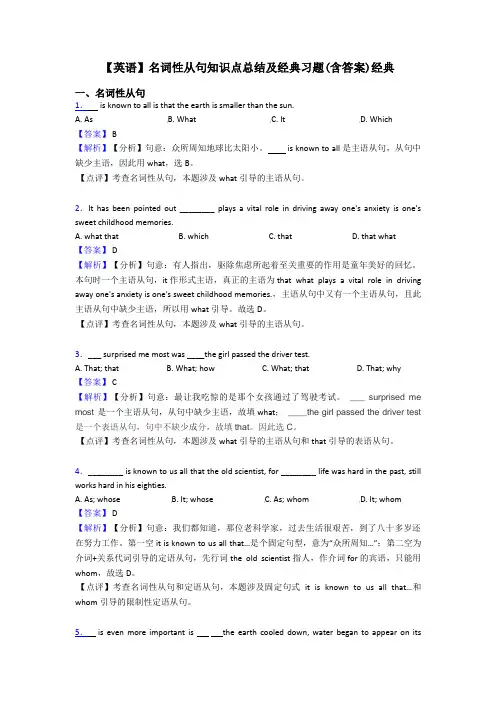
【英语】名词性从句知识点总结及经典习题(含答案)经典一、名词性从句1. is known to all is that the earth is smaller than the sun.A. AsB. WhatC. ItD. Which【答案】 B【解析】【分析】句意:众所周知地球比太阳小。
is known to all 是主语从句,从句中缺少主语,因此用what,选B。
【点评】考查名词性从句,本题涉及what引导的主语从句。
2.It has been pointed out ________ plays a vital role in driving away one's anxiety is one's sweet childhood memories.A. what thatB. whichC. thatD. that what【答案】 D【解析】【分析】句意:有人指出,驱除焦虑所起着至关重要的作用是童年美好的回忆。
本句时一个主语从句,it作形式主语,真正的主语为that what plays a vital role in driving away one's anxiety is one's sweet childhood memories.,主语从句中又有一个主语从句,且此主语从句中缺少主语,所以用what引导。
故选D。
【点评】考查名词性从句,本题涉及what引导的主语从句。
3.___ surprised me most was ____the girl passed the driver test.A. That; thatB. What; howC. What; thatD. That; why【答案】 C【解析】【分析】句意:最让我吃惊的是那个女孩通过了驾驶考试。
___ surprised me most是一个主语从句,从句中缺少主语,故填what;____the girl passed the driver test 是一个表语从句,句中不缺少成分,故填that。
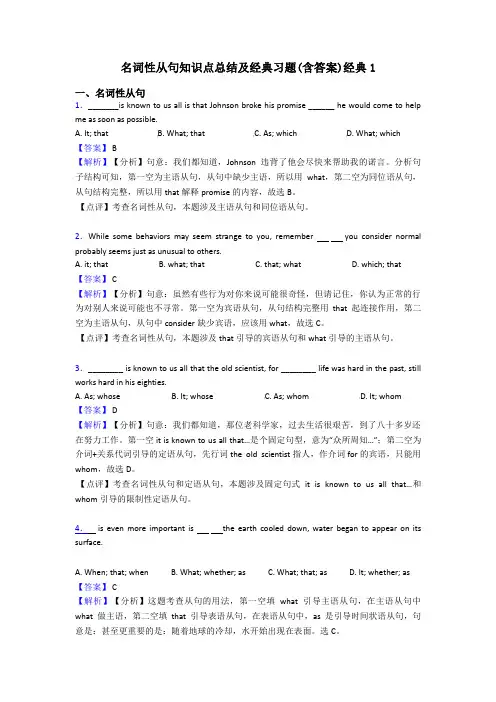
名词性从句知识点总结及经典习题(含答案)经典1一、名词性从句1._______is known to us all is that Johnson broke his promise ______ he would come to help me as soon as possible.A. It; thatB. What; thatC. As; whichD. What; which【答案】 B【解析】【分析】句意:我们都知道,Johnson违背了他会尽快来帮助我的诺言。
分析句子结构可知,第一空为主语从句,从句中缺少主语,所以用what,第二空为同位语从句,从句结构完整,所以用that解释promise的内容,故选B。
【点评】考查名词性从句,本题涉及主语从句和同位语从句。
2.While some behaviors may seem strange to you, remember you consider normal probably seems just as unusual to others.A. it; thatB. what; thatC. that; whatD. which; that【答案】 C【解析】【分析】句意:虽然有些行为对你来说可能很奇怪,但请记住,你认为正常的行为对别人来说可能也不寻常。
第一空为宾语从句,从句结构完整用that起连接作用,第二空为主语从句,从句中consider缺少宾语,应该用what,故选C。
【点评】考查名词性从句,本题涉及that引导的宾语从句和what引导的主语从句。
3.________ is known to us all that the old scientist, for ________ life was hard in the past, still works hard in his eighties.A. As; whoseB. It; whoseC. As; whomD. It; whom【答案】 D【解析】【分析】句意:我们都知道,那位老科学家,过去生活很艰苦,到了八十多岁还在努力工作。
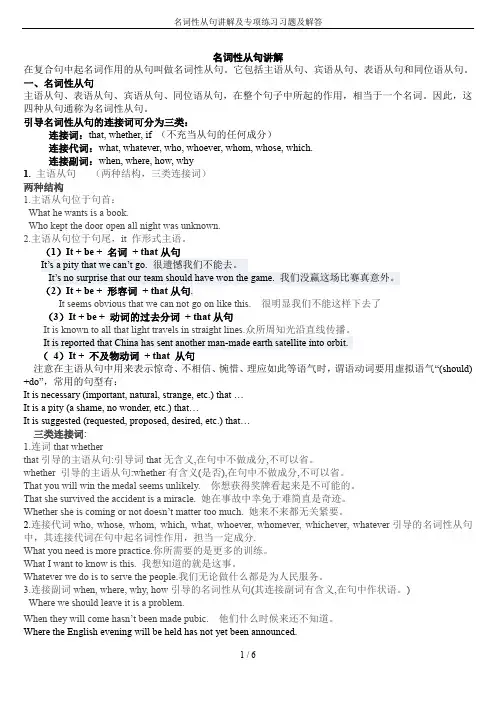
名词性从句讲解在复合句中起名词作用的从句叫做名词性从句。
它包括主语从句、宾语从句、表语从句和同位语从句。
一、名词性从句主语从句、表语从句、宾语从句、同位语从句,在整个句子中所起的作用,相当于一个名词。
因此,这四种从句通称为名词性从句。
引导名词性从句的连接词可分为三类:连接词:that, whether, if (不充当从句的任何成分)连接代词:what, whatever, who, whoever, whom, whose, which.连接副词:when, where, how, why1. 主语从句(两种结构,三类连接词)两种结构1.主语从句位于句首:What he wants is a book.Who kept the door open all night was unknown.2.主语从句位于句尾,it 作形式主语。
(1)It + be + 名词+ that从句It’s a pity that we can’t go. 很遗憾我们不能去。
It’s no surprise that our team should have wo n the game. 我们没赢这场比赛真意外。
(2)It + be + 形容词+ that从句.It seems obvious that we can not go on like this. 很明显我们不能这样下去了(3)It + be + 动词的过去分词+ that从句It is known to all that light travels in straight lines.众所周知光沿直线传播。
It is reported that China has sent another man-made earth satellite into orbit.(4)It + 不及物动词+ that 从句注意在主语从句中用来表示惊奇、不相信、惋惜、理应如此等语气时,谓语动词要用虚拟语气“(should) +do”,常用的句型有:It is necessary (important, natural, strange, etc.) that …It is a pity (a shame, no wonder, etc.) that…It is suggested (requested, proposed, desired, etc.) that…三类连接词:1.连词that whetherthat引导的主语从句:引导词that无含义,在句中不做成分,不可以省。
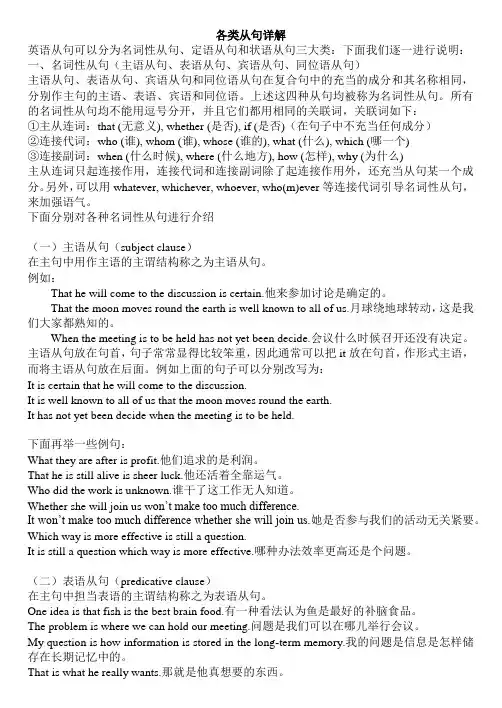
各类从句详解英语从句可以分为名词性从句、定语从句和状语从句三大类:下面我们逐一进行说明:一、名词性从句(主语从句、表语从句、宾语从句、同位语从句)主语从句、表语从句、宾语从句和同位语从句在复合句中的充当的成分和其名称相同,分别作主句的主语、表语、宾语和同位语。
上述这四种从句均被称为名词性从句。
所有的名词性从句均不能用逗号分开,并且它们都用相同的关联词,关联词如下:①主从连词:that (无意义), whether (是否), if (是否)(在句子中不充当任何成分)②连接代词:who (谁), whom (谁), whose (谁的), what (什么), which (哪一个)③连接副词:when (什么时候), where (什么地方), how (怎样), why (为什么)主从连词只起连接作用,连接代词和连接副词除了起连接作用外,还充当从句某一个成分。
另外,可以用whatever, whichever, whoever, who(m)ever等连接代词引导名词性从句,来加强语气。
下面分别对各种名词性从句进行介绍(一)主语从句(subject clause)在主句中用作主语的主谓结构称之为主语从句。
例如:That he will come to the discussion is certain.他来参加讨论是确定的。
That the moon moves round the earth is well known to all of us.月球绕地球转动,这是我们大家都熟知的。
When the meeting is to be held has not yet been decide.会议什么时候召开还没有决定。
主语从句放在句首,句子常常显得比较笨重,因此通常可以把it放在句首,作形式主语,而将主语从句放在后面。
例如上面的句子可以分别改写为:It is certain that he will come to the discussion.It is well known to all of us that the moon moves round the earth.It has not yet been decide when the meeting is to be held.下面再举一些例句:What they are after is profit.他们追求的是利润。
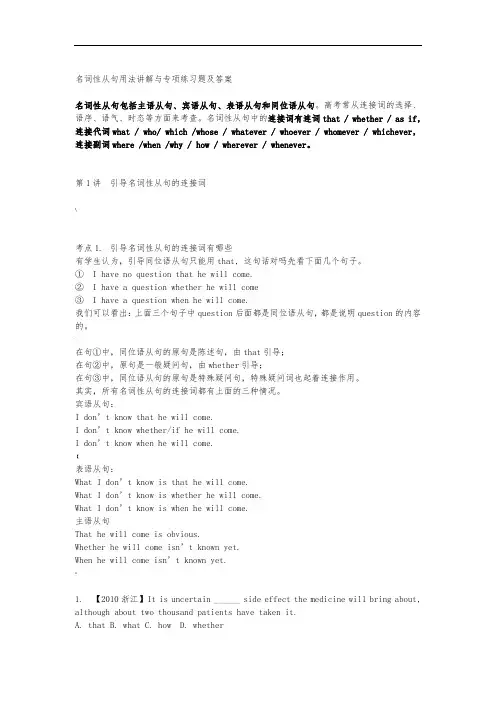
名词性从句用法讲解与专项练习题及答案名词性从句包括主语从句、宾语从句、表语从句和同位语从句。
高考常从连接词的选择、语序、语气、时态等方面来考查。
名词性从句中的连接词有连词that / whether / as if,连接代词what / who/ which /whose / whatever / whoever / whomever / whichever,连接副词where /when /why / how / wherever / whenever。
第1讲引导名词性从句的连接词\考点1. 引导名词性从句的连接词有哪些有学生认为,引导同位语从句只能用that, 这句话对吗先看下面几个句子。
①I have no question that he will come.②I have a question whether he will come③I have a question when he will come.我们可以看出:上面三个句子中question后面都是同位语从句,都是说明question的内容的。
~在句①中,同位语从句的原句是陈述句,由that引导;在句②中,原句是一般疑问句,由whether引导;在句③中,同位语从句的原句是特殊疑问句,特殊疑问词也起着连接作用。
其实,所有名词性从句的连接词都有上面的三种情况。
宾语从句:I don’t know that he will come.I don’t know whether/if he will come.I don’t know when he will come.【表语从句:What I don’t know is that he will come.What I don’t know is whether he will come.What I don’t know is when he will come.主语从句That he will come is obvious.Whether he will come isn’t known yet.When he will come isn’t known yet.^1. 【2010浙江】It is uncertain ______ side effect the medicine will bring about, although about two thousand patients have taken it.A. thatB. whatC. howD. whether2. 【2012全国新课标】It is by no means clear ______ the president can do to end the strike.A. howB. whichC. thatD. what3. 【2012山东】It doesn’t matter ______ you pay by cash or credit card in this store.A. howB. whetherC. whatD. why4. 【2013陕西】It remains to be seen ______ the newly formed committee’s policy can be put into practice.]A. thatB. whichC. whatD. whether5. 【2009天津】It is obvious to the students ______ they should get well prepared for their future.A. asB. whichC. whetherD. that6. 【2012江西】It suddenly occurred to him ______ he had left his keys in the office.A. whetherB. whereC. whichD. that考点2. 引导词that的省略问题主语从句、表语从句、同位语从句中连词that不能省略。
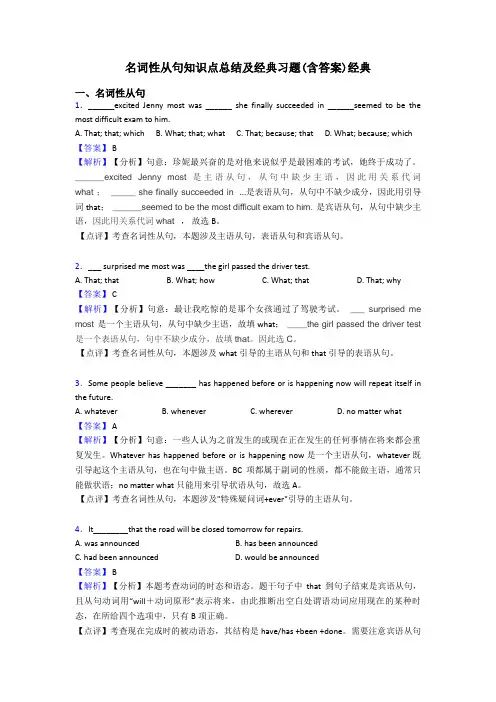
名词性从句知识点总结及经典习题(含答案)经典一、名词性从句1.______excited Jenny most was ______ she finally succeeded in ______seemed to be the most difficult exam to him.A. That; that; whichB. What; that; whatC. That; because; thatD. What; because; which 【答案】 B【解析】【分析】句意:珍妮最兴奋的是对他来说似乎是最困难的考试,她终于成功了。
______excited Jenny most是主语从句,从句中缺少主语,因此用关系代词what ;_____ she finally succeeded in ...是表语从句,从句中不缺少成分,因此用引导词that;______seemed to be the most difficult exam to him.是宾语从句,从句中缺少主语,因此用关系代词what ,故选B。
【点评】考查名词性从句,本题涉及主语从句,表语从句和宾语从句。
2.___ surprised me most was ____the girl passed the driver test.A. That; thatB. What; howC. What; thatD. That; why【答案】 C【解析】【分析】句意:最让我吃惊的是那个女孩通过了驾驶考试。
___ surprised me most是一个主语从句,从句中缺少主语,故填what;____the girl passed the driver test 是一个表语从句,句中不缺少成分,故填that。
因此选C。
【点评】考查名词性从句,本题涉及what引导的主语从句和that引导的表语从句。
3.Some people believe _______ has happened before or is happening now will repeat itself in the future.A. whateverB. wheneverC. whereverD. no matter what【答案】 A【解析】【分析】句意:一些人认为之前发生的或现在正在发生的任何事情在将来都会重复发生。
名词性从句名词性从句(主语从句,表语从句,宾语从句,同位语从句)1.that 引导的名词性从句,that 在从句中不充当任何句子成分,没有词义。
that引导宾语从句时常可省略,但如果引导两个以上宾语从句时,that不省。
引导主语从句时常可用it 作形式主语That light travels in straight lines is known to all.众所周知光是以直线运行的。
(主语从句)=It is known to all that light travels in straight linesThe reason for his absent was that he was ill.他缺席的原因是他病了。
(表语从句)I think( that) you are right.我认为你是对的。
(宾语从句)The news that our football team has won is true.我们足球队赢了的消息是真的。
(同位语从句)注意区别:The news( that/which) he told me is true.他告诉我的消息是真的。
(定语从句)2.what 引导的名词性从句,what 在从句中必须要作主语,宾语,表语,常译作“所---的”或“什么”,what 一般不引导同位语从句What we need is water.我们所需要的是水。
(主语从句)What we need are useful books.我们所需要的是有用的书。
(主语从句)This is what I want to say.这就是我想说的。
(表语从句)Please tell me what she is saying.请告诉我她在说什么。
(宾语从句)3.how,where,when,why,等引导的名词性从句,保留疑问词的原意,或译为-“--的地方”“---的时候”Do you know how he came here?By bus.你知道他是怎么来的吗?乘公共汽车。
名词性从句在句子中起名词作用的从句叫名词性从句。
名词性从句的功能相当于名词词组,它在复合句中能担任主语、宾语、表语、同位语,因此根据它在句中不同的语法功能,名词性从句又可分为主语从句、宾语从句、表语从句、同位语从句。
引导名词性从句的词叫做连接词,包括:1. 连词(在名词性从句中只起连接作用,不作成分)2. 连接代词(在名词性从句中作主语、宾语或表语)3. 连接副词(在名词性从句中作状语)所有的名词性从句的语序都是陈述句语序。
主语从句:是在主句中作主语的从句。
它由连接词引导,通常位于谓语动词之前。
连接词:1. 连词:在从句中不充当任何成分,常见的引导主语从句的连词有that, whether。
That he got the first prize excited him much.他获得一等奖一事使他非常兴奋。
It is doubtful whether we can get there on time.我们能否按时到达那儿还不确定。
1)that引导的主语从句:在从句中不作任何成分,也没有实际意义。
一般情况下that不可省略。
That light travels in straight lines is known to all.众所周知,光沿直线传播。
That you don't like him is none of my business.你不喜欢他不关我的事。
2)whether引导的主语从句:常置于句首,表示“是否”之意;if一般不引导主语从句。
Whether he can finish his task on time is of greatimportance.他是否能按时完成任务非常重要。
Whether you can succeed or not depends on how hard you work at it.你能否成功取决于你努力的程度。
连接代词:在从句中起名词或代词的作用,常作从句的主语、宾语、表语或定语,有具体意义且不能省略。
v1.0 可编辑可修改1高考英语名词性从句讲解【考情剖析】名词性从句是历年高考的重点和难点也是热点。
名词性从句相当于名词,可用作主句的主语、表语、宾语和同位语。
因此,名词性从句分为主语从句、表语从句、宾语从句和同位从句。
引导名词性从句的衔接词有:衔接代词:who, whose, whom, what, which ,有词义,在从句中担任成分,如主语、表语、宾语、或定语等;衔接副词:when, where, why, how ,有词义,在从句中担任成分,作状语;衔接词:that, whether, if, as if ,if (whether), as if 虽有词义,但在从句中不担任成分;that 无词义,在从句中不担任成分,有时可省略。
今后对名词性从句的考查仍将集中在关联词的选用上,特别石堆what 引导的名词性从句的考查。
名词性从句与其他从句的混合考查将在今后高考中占据一席之地。
易混句型的辨析,比如it 作方式主语,主语从句后置的句型与强调句型的辨析将仍作为高考考查的重点。
【知识点归纳】名词性从句的用法在句子中起名词作用的句子叫名词从句 (Noun Clauses )。
名词从句的功用相当于名词词组, 它在复合句中能担任主语、宾语、表语、同位语、介词宾语等,因此根据它在句中不一样的语法功用,名词从句又可区分称为主语从句、宾语从句、表语从句和同位语从句。
一、引导名词性从句的衔接词引导名词性从句的衔接词可分为三类:连词:that (无任何词意);whether, if (均表示“能不能”标明从句内容的不确定性);as if ,as though (均表示“似乎”,“似乎”)。
以上在从句中均不充任任何成分衔接代词:what, whatever, who, whoever, whom, whose, which. Whichever, whomever 衔接副词:when, where, how, why 不可省略的连词: 1. 介词后的连词2. 引导主语从句和同位语从句的连词不可省略。
名词性从句精选题库与答案解析一、选择题1. "______ she will come to our party or not is still uncertain."A. ThatB. WhetherC. WhyD. What答案:B. Whether解析:该句中起连接作用的词引导的是一个名词性从句,表示一个选择或是某种不确定情况。
Whether在这里引导的是一个宾语从句,用来表示她是否会来参加我们的聚会。
2. "I don't know ______ he is going to do with the money."A. whenB. whyC. whereD. what答案:D. what解析:该句中的名词性从句作为宾语补足语出现,用来补充说明主语"I"不知道的是关于金钱的具体事项,所以应使用连接词"what"。
3. "______ really matters is your attitude towards life."A. WhatB. ThatC. WhetherD. How答案:A. What解析:该句中的名词性从句作为主语出现,用来说明真正重要的是什么。
"What"在这里引导的是一个主语从句。
4. "Please tell me _______ you need any help."A. whileB. whetherC. howD. where答案:B. whether解析:该句中的名词性从句作为宾语出现,用来询问对方是否需要帮助。
Whether在这里引导的是一个宾语从句。
5. "I have no idea _______ he will arrive."A. whenB. whyC. whereD. what答案:A. when解析:该句中的名词性从句作为宾语补足语出现,用来说明主语"I"不知道的是他什么时候会到达。
一、概念:在句子中起名词作用的句子叫名词性从句(Noun Clauses)。
名词性从句的功能相当于名词词组, 它在复合句中能担任主语、宾语、表语、同位语、介词宾语等,因此根据它在句中不同的语法功能,名词从句又可分别称为主语从句、宾语从句、表语从句和同位语从句。
Who will go makes no difference. 谁去都没关系。
(从句)The trouble is that she has lost his address.麻烦的是她把他的地址搞丢了。
(从句)They have no idea at all where he has gone.他们不知道他去什么地方了。
(从句)Do you remember how he came? 你记得他怎么来的么?(从句)二、语序当名词性从句要采用陈述句语序。
由一个含疑问意义的连词引起时,必须将该连词放在名词性从句的开头,且该从句语序不能倒装。
What we can't get seems better than what we have.我们得不到的似乎比我们所拥有的要好。
Can you make sure where Alice has put the gold ring? 你能肯定爱丽丝放金戒指的地方吗?No one can be sure what man will look like in a million years. 没有人肯定一百万年后人类会是什么样子。
He asked how much I paid for the violin.他问我花了多少钱买这个小提琴。
三、时态的呼应名词性从句特别是宾语从句中谓语动词的时态要与主句中谓语动词时态要相呼应,主要有下列几种情况:(1)如果主句中的谓语动词是一般现在时态,从句的谓语动词的时态不受主句谓语动词时态的制约,从句的谓语可根据意思的需要使用任何一种时态。
I wonder why Jenny hasn’t written us recently. We should have heard from her by now.我不知道为什么珍妮最近没有给我们写信。
名词性从句讲解在复合句中起名词作用的从句叫做名词性从句。
它包括主语从句、宾语从句、表语从句和同位语从句。
名词性从句是中学阶段的一个重要语法项目,在历年的高考中几乎都涉及到,并且每年的命题各有变化。
分析历届高考试题名词性从句考查的焦点主要有以下六个方面1. 考查名词性从句的语序问题2. 考查引导词that 与what 的区别3. 考查it 在名词性从句中作形式主语或形式宾语的用法4. 考查whether 与if 的区别5. 考查名词性从句中的疑问词+ever 引导的名词性从句与no matter+疑问词引导的状语从句的区别6. 考查名词性从句的虚拟语气问题语法要点剖析一、名词性从句主语从句、表语从句、宾语从句、同位语从句,在整个句子中所起的作用,相当于一个名词。
因此,这四种从句通称为名词性从句。
引导名词性从句的连接词可分为三类:连接词:that, whether, if (不充当从句的任何成分)连接代词:what, whatever, who, whoever, whom, whose, which.连接副词:when, where, how, why1.主语从句作句子主语的从句叫主语从句。
主语从句通常由从属连词that,whether,if 和连接代词what,who,which,whatever,whoever 以及连接副词how,when,where,why 等词引导。
that 在句中无词义,只起连接作用;连接代词和连接副词在句中既保留自己的疑问含义、又起连接作用,在从句中充当从句的成分。
例如:What he wants to tell us is not clear. 他要跟我们说什么,还不清楚。
It is known to us how he became a writer. 我们都知道他是如何成为一名作家的。
Where the English evening will be held has not yet been announced.英语晚会将在哪里举行,还没有宣布。
名词性从句名词性从句是在句子中起名词作用的句子。
名词性从句的功能相当于名词词组,它在复合句中能担任主语、宾语、表语、同位语、介词宾语等,因此根据它在句中不同的语法功能,名词性从句又可分别称为主语从句、宾语从句、表语从句和同位语从句。
连接词引导名词性从句的连接词可分为三类:1.连词:that (本身无意义。
引导单一的宾语从句时that常可省略,但引导主语从句、表语从句、同位语从句时that通常不被省略)whether,if (均表示“是否”)as if ,as though (均表示“好像”,“似乎”)◆以上在从句中均不充当任何成分2.连接代词:what/ whatever, who/ whoever, whom/ whomever, whose/whosever, which/whichever.有词意,在从句中充当主语,宾语,表语,定语等。
3.连接副词:when/ whenever, where/ wherever, how/ however, why.有词意,在从句中充当状语。
主语从句作句子主语的从句叫主语从句。
主语从句通常由连词that,whether,和连接代词what,who,which,whatever,whoever以及连接副词how,when,where,why等词引导。
that 在句中无词义,只起连接作用;连接代词和连接副词在句中既保留自己的疑问含义、又起连接作用,在从句中充当一定的成分。
主语从句后的谓语动词一般用单数形式。
例如:What he wants to tell us is not clear. 他要跟我们说什么,还不清楚。
Who will win the match is still unknown. 谁能赢得这场比赛还不得而知。
It is known to us how he became a writer. 我们都知道他是如何成为一名作家的。
Where the English evening will be held has not yet been announced. 英语晚会将在哪里举行,还没有宣布。
有时为避免句子头重脚轻,常用形式主语it代替主语从句作形式主语放于句首,而把主语从句置于句末。
常用句型如下:用it 作形式主语的结构(1)It is +名词+从句It is a fact that … 事实是…It is an honor that …非常荣幸It is no wonder that 难怪…(2) It is +形容词+从句It is natural that… 很自然…It is strange that… 奇怪的是…(3) It is +不及物动词+从句It seems that… 似乎…It happened that… 碰巧…It appears that… 似乎…It occurre d to me that…我突然想起……(4) It +过去分词+从句It is reported that… 据报道…It has been proved that… 已证实…It is said that… 据说…另注意在主语从句中用来表示惊奇、不相信、惋惜、理应如此等语气时,谓语动词要用虚拟语气“(should) +do”,常用的句型有:It is necessary (important, natural, strange, etc.) that …It is suggested (requested, proposed, desired, etc.) that…众所周知的几种表达方式(1)It is known to us that.(2)As is known to us.(3)what is known to us is that.【注意】与强调句结构的区分:It is/was+被强调部分+that/who+句子其它部分。
It is John that broke the window. 是John打碎的窗户。
(强调句型)宾语从句宾语从句就是在复合句中作宾语的名词性从句,通常放在主句谓语动词 (及物动词) 或介词之后。
I.位置1.作动词的宾语(1) 由that引导的宾语从句(that在句中不担任任何成分,在口语或非正式的文体中常被省去,但如果从句是并列句时,第二个分句前的that不可省。
), 例如:I heard that be joined the army. 我听说他参军了。
(2) 由what, whether (if) 引导的宾语从句,例如:She did not know what had happened. 她不知道发生了什么。
I wonder whether you can change this note for me. 我想知道你是否能帮我改一下笔记。
(3) 动词+间接宾语+宾语从句。
例如:She told me that she would accept my invitation. 她对我说她会接受我的邀请。
2. 作介词的宾语Our success depends upon how well we can cooperate with one another. 我们的成功取决于我之间的合作。
3. 作形容词的宾语I am afraid (that) I’ve made a mistake.我恐怕我已经犯了一个错误。
注意:that 引导的从句常跟在下列形容词后作宾语:anxious, aware, certain, confident, convinced, determined, glad, proud, surprised, worried, sorry, thankful, ashamed, disappointed, annoyed, pleased, hurt, satisfied, content 等。
也可以将此类词后的that 从句的看作原因状语从句。
II. it 可以作为形式宾语1.动词make, find ,think,feel,consider,believe等后面有宾语补足语的时候,则需要用it做形式主语,而将that宾语从句后置。
I think it necessary that we take plenty of hot water every day.我认为每天多喝开水是有必要的。
I feel it a pity that I haven't been to the get-together.我没去聚餐,感觉非常遗憾。
2.动词+it+when / if 从句.常见于appreciate, enjoy, like, dislike, love, hate,prefer等少数动词之后。
We would much appreciate it if you could do us that favour.要是你们能帮我们这个忙,我们将非常感激。
I'd prefer it if I didn't have to finish the work.要是我不必完成那项工作,那就太好了。
3.动词+ it + that从句。
常见于like, take, have, put等少数动词之后。
I take it that they will succeed sooner or later.我认为他们迟早会成功的。
The newspapers have it that some Japanese firms have gone bankrupt.报上说一些日本商号破产了。
4.动词 + it + 介词短语 + that从句。
常见于bring it to one's attention;owe it to sb; take it for granted 等结构中。
I owe it to you that I finished my work in time.多亏有你我才及时完成了工作。
Don't take it for granted that they will support you.不要想当然地认为他们会支持你。
5.动词 + 介词(短语) + it + that从句。
常见于answer for, depend on, rely on, insist on, see to, 等结构中。
I'll see to it that everything is ready in time.我将负责按时做好一切准备。
You may depend on it that Tom will help you with your English.你放心,汤姆会帮助你学英语的。
6.动词+ it +过去分词+从句。
常见于几个可以带过去分词作宾语补足语的动词之后。
I heard it said that that factory was founded in 1995.我听说那家工厂是1995年创建的。
They haven't made it known where the meeting is to take place.他们没有宣布会议在哪里召开。
III. 否定的转移若主句谓语动词为think, consider, suppose, believe, expect, fancy, guess, imagine 等,其后的宾语从句若含有否定意义,一般要把否定词转移到主句谓语上,从句谓语用肯定式。
例如:I don’t think this dress fits you well. 我认为这件衣服不适合你穿。
I don' t believe he will come. 我相信他不会回来。
IV宾语从句中虚拟语气的运用注意:在demand、order、suggest、insist, desire, request, command, 等表示要求、命令、建议、等意义的动词后,宾语从句常用“(should)+ 动词原形”。
I insist that she (should) do her work alone. 我坚持要她自己工作。
The commander ordered that troops (should) set off at once. 司令员命令部队马上出发。
表语从句在复合句中,位于系动词之后作表语的从句叫表语从句。
引导表语从句的关联词与引导主语从句的关联词大致一样,表语从句位于系动词后,有时用as if引导。
其基本结构为:主语+ 连系动词+ that从句1.that 引导表语从句,无词义,只起连接作用,不可省。
2.连系动词可为be,look,seem,sound,appear等。